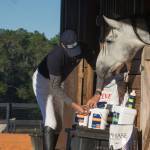Feeding a New Horse

Coupled with the excitement of a new horse comes the concern of caring for it properly. One management element that sometimes causes apprehension involves proper nutrition. What’s the best way to make the nutritional transfer from one home to the next without upsetting a delicate gastrointestinal system?
As with all dietary changes, the switchover requires forethought. Keep these tips in mind.
Toss in a bag of grain, too, please. Before finalizing the purchase of a horse, ask for a complete inventory of the horse’s diet, including what kind and how much hay, pasture, feed, and supplements he consumes daily. If you cannot get the same brand of feed in your area, ask the seller if he’d be willing to sell or toss into the deal a bag of feed. This will provide plenty of feed to slowly familiarize the horse to a different program. Switching out a half pound of old feed for new feed will allow the microorganisms of the hindgut to slowly acclimate to the new feed, and the changeover can be accomplished in one to two weeks. The same should be done for hay. Many horse owners realize that making abrupt changes in a horse’s concentrate can cause problems, such as colic or diarrhea, but those same health issues are possible with sudden changes in hay or pasture.
No feed to send along? No problem. If the seller cannot part with a bag of feed, don’t sweat it. Once you’ve selected an appropriate feed based on the horse’s age and work intensity, begin to feed it slowly, adding about one-half pound each day until he is consuming the recommended level. Before adding supplements, horse owners may wish to wait until the horse is eating several pounds of feed per day, which allows for additives to be mixed well into a meal. This is especially important if the horse is fussy about accepting supplements in feed.
Have pasture, will graze. Accustoming a horse to a new stand of pasture should be done in much the same way as acclimating him to feed—gradually. More specifically, the speed of acclimation depends on the horse’s history. If the horse spent the majority of its time in a stall, drylot, or overgrazed pasture, begin by allowing an hour of pasture and increasing by an hour or so each day. If, on the other hand, the horse was previously in a pasture situation with about the same type and quality of forage, he can be acclimated more quickly, in four- to six-hour blocks, making the complete transition in four to six days.
Take a tour. Before you unsnap the shank from your new horse’s halter, releasing him into his new pasture, it might be wise to walk him around the new field or drylot, assuming there are no other horses or ponies in the enclosure to complicate matters. Some horse owners feel comfortable walking the entire perimeter of the field with the horse, allowing the horse to take in the physical boundaries of the pasture. At the very least, show the horse where to find water.
One reason nutritionists underscore the importance of gradual changes in diet is because of the delicacy of the microorganism population in the hindgut. Microbes are most efficient when they are fed a steady supply of forage, and changing a diet too rapidly can upset these beneficial microbes. To keep the hindgut working optimally, choose a supplement designed to maintain appropriate pH such as EquiShure. By using proprietary time-release technology, EquiShure delivers an effective buffer into the hindgut, easing problems associated with a changing diet.
Most horses relocate from one place to another with few problems. When in doubt about how best to proceed, always choose the cautious approach.
Do you have a question about feeding your new horse? Ask a Kentucky Equine Research (KER) nutrition advisor today.








